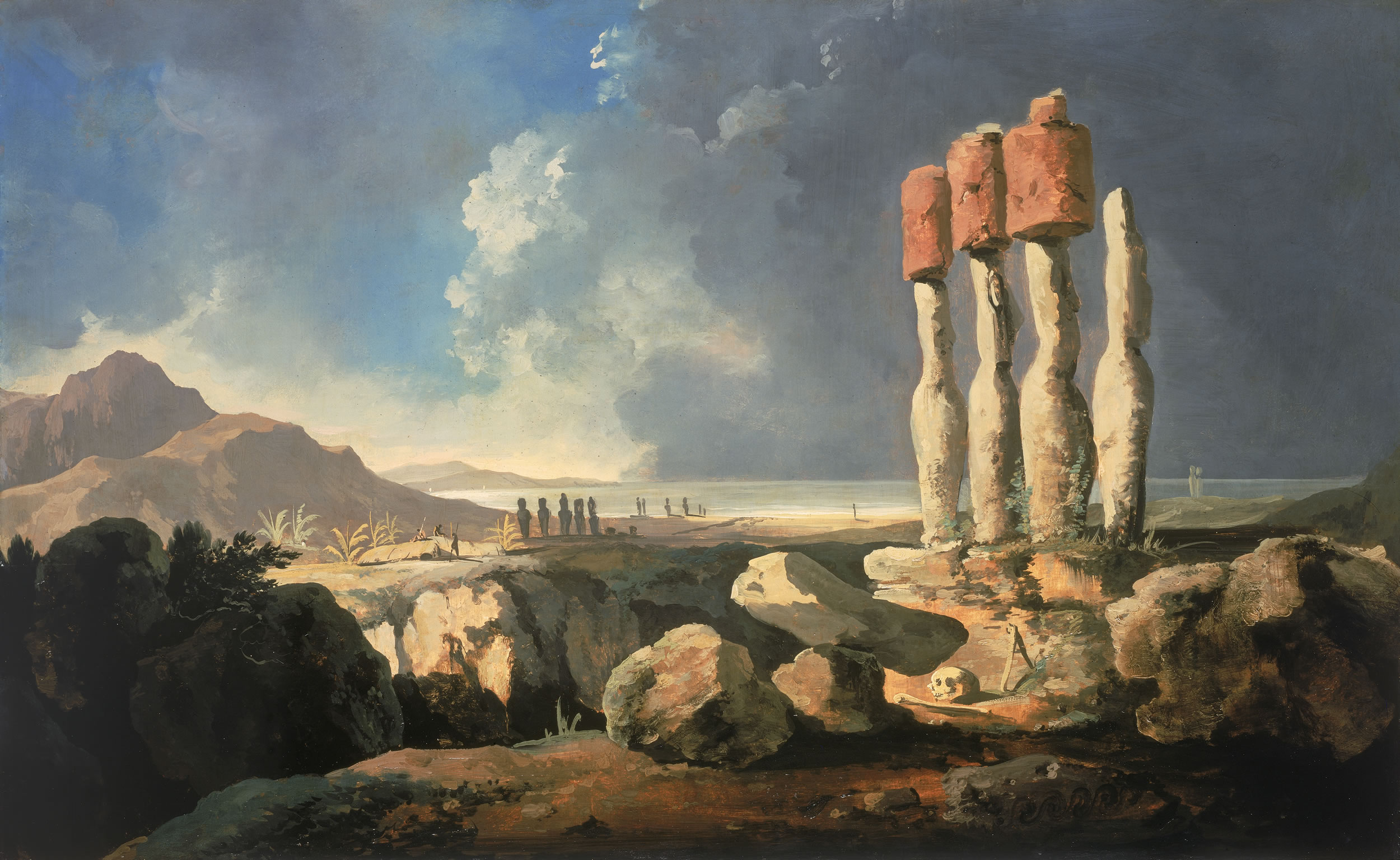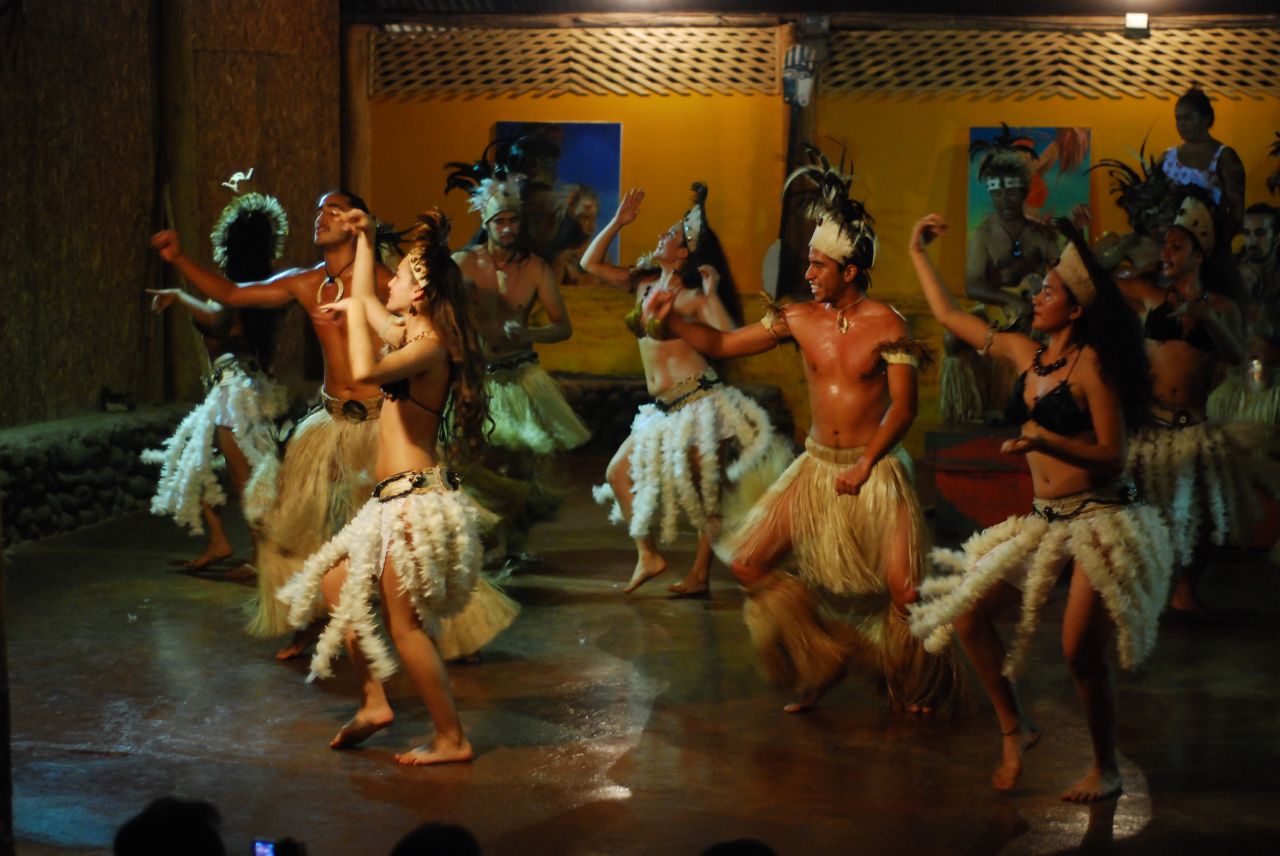|
Pukao
Pukao are the hat-like structures or topknots formerly placed on top of some moai statues on Easter Island. They were all carved from a very light-red volcanic scoria, which was quarried from a single source at Puna Pau. Symbolism Pukao were not made until the 15th– 16th centuries and are later additions to the moai. The reason that pukao were made is not known, though various theories exist. One is that the placing of a pukao on top of the moai was a recognition of the power of the individual represented. This has credibility because such a task at the time was, and even now is, extremely difficult, especially because no evidence has been found of crane technology existing at the time. Another theory is that the pukao serve to distinguish between statues. Those moai with pukao are meant to be shown as more majestic and important. This distinction may have also indicated to islanders those statues at which various rituals should be performed. Pukao are now believed to represen ... [...More Info...] [...Related Items...] OR: [Wikipedia] [Google] [Baidu] |
Easter Island
Easter Island (, ; , ) is an island and special territory of Chile in the southeastern Pacific Ocean, at the southeasternmost point of the Polynesian Triangle in Oceania. The island is renowned for its nearly 1,000 extant monumental statues, called ''moai'', which were created by the early Rapa Nui people. In 1995, UNESCO named Easter Island a World Heritage Site, with much of the island protected within Rapa Nui National Park. Experts differ on when the island's Polynesian inhabitants first reached the island. While many in the research community cited evidence that they arrived around the year 800, a 2007 study provided compelling evidence suggesting their arrival was closer to 1200. The inhabitants created a thriving and industrious culture, as evidenced by the island's numerous enormous stone ''moai'' and other artifacts. Land clearing for cultivation and the introduction of the Polynesian rat led to gradual deforestation. By the time of European arrival in 1722, the i ... [...More Info...] [...Related Items...] OR: [Wikipedia] [Google] [Baidu] |
Moai
Moai or moʻai ( ; ; ) are monolithic human figures carved by the Rapa Nui people on Easter Island, Rapa Nui (Easter Island) in eastern Polynesia between the years 1250 and 1500. Nearly half are still at Rano Raraku, the main moai quarry, but hundreds were transported from there and set on stone platforms called Ahu (Easter Island), ahu around the island's perimeter. Almost all moai have overly large heads, which account for three-eighths of the size of the whole statue. They also have no legs. The moai are chiefly the living faces (''aringa ora'') of deified ancestors (''aringa ora ata tepuna''). The statues still gazed inland across their clan lands History of Easter Island#European contacts, when Europeans first visited the island in 1722, but all of them had fallen by the latter part of the 19th century. The moai were toppled in the late 18th and early 19th centuries, possibly as a result of European contact or endemic warfare, internecine tribal wars. The production and tr ... [...More Info...] [...Related Items...] OR: [Wikipedia] [Google] [Baidu] |
Rapa Nui People
The Rapa Nui (Rapa Nui: , Spanish: ) are the Indigenous Polynesian peoples of Easter Island. The easternmost Polynesian culture, the descendants of the original people of Easter Island make up about 60% of the current Easter Island population and have a significant portion of their population residing in mainland Chile. They speak both the traditional Rapa Nui language and the primary language of Chile, Spanish. At the 2017 census there were 7,750 island inhabitants—almost all living in the village of Hanga Roa on the sheltered west coast. As of 2011, Rapa Nui's main source of income derived from tourism, which focuses on the giant sculptures called moai. Over the past decade, Rapa Nui activists have been fighting for self-determination and sovereignty over their lands. Protests in 2010 and 2011 by the Indigenous Rapa Nui on Easter Island, objecting to the creation of a marine park and reserve, have led to clashes with Chilean police. History Pre-European contact (300 ... [...More Info...] [...Related Items...] OR: [Wikipedia] [Google] [Baidu] |
Ahu Tahai
The Tahai Ceremonial Complex is an archaeological site on Rapa Nui (Easter Island) in Chilean Polynesia. Restored in 1974 by American archaeologist William Mulloy, Tahai comprises three principal ''ahu'' from north to south: Ko Te Riku (with restored eyes), Tahai, and Vai Ure. Visible in the distance from Tahai are two restored ''ahu'' at Hanga Kio'e, projects that Mulloy undertook in 1972. Like other Mulloy restoration projects at Ahu Akivi, the ceremonial village of Orongo and Vinapu, the ceremonial center at Tahai now constitutes an integral part of the Rapa Nui National Park, designated by UNESCO as a World Heritage World Heritage Sites are landmarks and areas with legal protection under an treaty, international treaty administered by UNESCO for having cultural, historical, or scientific significance. The sites are judged to contain "cultural and natural ... site. William Mulloy and his wife Emily Ross Mulloy are buried at Tahai. References * Mulloy, W.T., and S.R. ... [...More Info...] [...Related Items...] OR: [Wikipedia] [Google] [Baidu] |
Scoria
Scoria or cinder is a pyroclastic, highly vesicular, dark-colored volcanic rock formed by ejection from a volcano as a molten blob and cooled in the air to form discrete grains called clasts.Neuendorf, K.K.E., J.P. Mehl, Jr., and J.A. Jackson, eds. (2005) ''Glossary of Geology'' (5th ed.). Alexandria, Virginia, American Geological Institute. 779 pp. It is typically dark in color (brown, black or purplish-red), and basaltic or andesitic in composition. Scoria has relatively low density, as it is riddled with macroscopic ellipsoidal vesicles (gas bubbles), but in contrast to pumice, scoria always has a specific gravity greater than 1 and sinks in water. Scoria may form as part of a lava flow, typically near its surface, or as fragmental ejecta ( lapilli, blocks, and bombs), for instance in Strombolian eruptions that form steep-sided scoria cones, also called cinder cones. Scoria's holes or vesicles form when gases dissolved in the original magma come out of solution as it er ... [...More Info...] [...Related Items...] OR: [Wikipedia] [Google] [Baidu] |
Puna Pau
Maunga Puna Pau is a small crater or cinder cone and prehistoric quarry on the outskirts of Hanga Roa in the south west of Easter Island (a Chilean island in the Pacific Ocean). Puna Pau gives its name to one of the seven regions of the Rapa Nui National Park. Puna Pau was the sole source of the red scoria that the prehistoric Rapanui used to carve the pukao (topknots) that they put on the heads of some of their iconic moai Moai or moʻai ( ; ; ) are monolithic human figures carved by the Rapa Nui people on Easter Island, Rapa Nui (Easter Island) in eastern Polynesia between the years 1250 and 1500. Nearly half are still at Rano Raraku, the main moai quarry, but h ... statues. The stone from Puna Pau was also used for ahu facia blocks and a non-standard moai found in front of one of the ahu at Vinapu. It was not used to fashion the crouching moai Tukuturi at Rano Raraku, which is of Rano Raraku tuff. Archaeological excavations were carried out at Puna Pau between 20 ... [...More Info...] [...Related Items...] OR: [Wikipedia] [Google] [Baidu] |
15th Century
The 15th century was the century which spans the Julian calendar dates from 1 January 1401 (represented by the Roman numerals MCDI) to 31 December 1500 (MD). In Europe, the 15th century includes parts of the Late Middle Ages, the Early Renaissance, and the early modern period. Many technological, social and cultural developments of the 15th century can in retrospect be seen as heralding the " European miracle" of the following centuries. The architectural perspective, and the modern fields which are known today as banking and accounting were founded in Italy. The Hundred Years' War ended with a decisive French victory over the English in the Battle of Castillon. Financial troubles in England following the conflict resulted in the Wars of the Roses, a series of dynastic wars for the throne of England. The conflicts ended with the defeat of Richard III by Henry VII at the Battle of Bosworth Field, establishing the Tudor dynasty in the later part of the century. Const ... [...More Info...] [...Related Items...] OR: [Wikipedia] [Google] [Baidu] |
16th Century
The 16th century began with the Julian calendar, Julian year 1501 (represented by the Roman numerals MDI) and ended with either the Julian or the Gregorian calendar, Gregorian year 1600 (MDC), depending on the reckoning used (the Gregorian calendar introduced a lapse of 10 days in October 1582). The Renaissance in Italy and Europe saw the emergence of important artists, authors and scientists, and led to the foundation of important subjects which include accounting and political science. Copernicus proposed the Copernican heliocentrism, heliocentric universe, which was met with strong resistance, and Tycho Brahe refuted the theory of celestial spheres through observational measurement of the SN 1572, 1572 appearance of a Milky Way supernova. These events directly challenged the long-held notion of an immutable universe supported by Ptolemy and Aristotle, and led to major revolutions in astronomy and science. Galileo Galilei became a champion of the new sciences, invented the first ... [...More Info...] [...Related Items...] OR: [Wikipedia] [Google] [Baidu] |
Jared Diamond
Jared Mason Diamond (born September 10, 1937) is an American scientist, historian, and author. In 1985 he received a MacArthur Genius Grant, and he has written hundreds of scientific and popular articles and books. His best known is '' Guns, Germs, and Steel'' (1997), which received multiple awards including the 1998 Pulitzer Prize for general nonfiction. In 2005, Diamond was ranked ninth on a poll by '' Prospect'' and ''Foreign Policy'' of the world's top 100 public intellectuals. Originally trained in biochemistry and physiology, Diamond has published in many fields, including anthropology, ecology, geography, and evolutionary biology. In 1999, he received the National Medal of Science, an honor bestowed by the President of the United States and the National Science Foundation. He was a professor of geography at UCLA until his retirement in 2024. Early life and education Diamond was born on September 10, 1937 in Boston, Massachusetts. His parents were both Eastern Europ ... [...More Info...] [...Related Items...] OR: [Wikipedia] [Google] [Baidu] |
Katherine Routledge
Katherine Maria Routledge ( ; ; 11 August 1866 – 13 December 1935) was an English archaeologist and anthropologist who, in 1914, initiated and carried out much of the first true survey of Easter Island. She was the second child of Kate and Gurney Pease, and was born into a wealthy Quaker family in Darlington, County Durham, northern England. She graduated from Somerville Hall (now Somerville College, Oxford), with Honours in Modern History in 1895, and for a while taught courses through the Extension Division and at Darlington Training College. After the Second Boer War, she traveled to South Africa with a committee to investigate the resettlement of single working women from England to South Africa. In 1906 she married William Scoresby Routledge. The couple went to live among the Kikuyu people of what was then British East Africa, and in 1910 jointly published a book of their research entitled ''With A Prehistoric People''. Easter Island In 1910 the Routledges decided ... [...More Info...] [...Related Items...] OR: [Wikipedia] [Google] [Baidu] |








